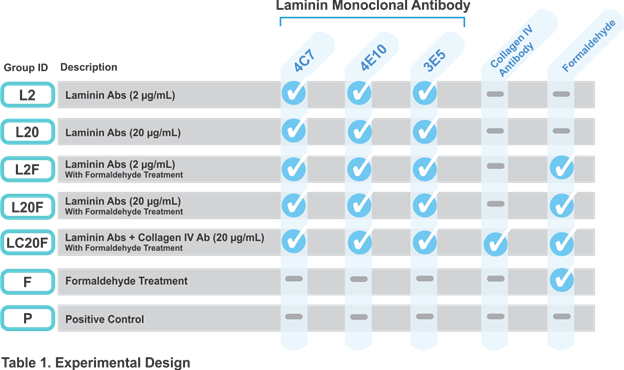Laminin Inhibition to Assess the Regenerative Potential of Peripheral Nerve Allografts
Kasra Tajdaran, MS Sc; Jennifer Faleris, BS; Mark Friedman, PhD; Erick DeVinney, BS; AxoGen, Alachua, FL
Introduction: Nerve processing methods have been shown to affect structural and biological activity of tissue. Previous studies have demonstrated that preservation of native extracellular matrix (ECM) structure improves the regenerative potential of processed nerve allografts (PNAs). Whilst the activity of basement membrane ECM proteins is known to promote nerve regeneration and contribute to the structure of the endoneurial tubes, their role has not been investigated in PNAs. To evaluate the necessity of maintaining these proteins, a three-dimensional in vitro assay was developed. The PNA’s regenerative capacity after treatment with functional blocking antibodies of laminin and collagen IV was analyzed via axonal outgrowth measurement. Basement membrane blocking was performed while maintaining the native ECM architecture.
Methods: All PNA samples were pre-treated as according to Table 1 Experimental Design. After pre-treatment, a rat DRG was secured on the end of each PNA with a thin collagen gel. Samples were then cultured for 7 days at 37 °C and 5% CO2. All samples were longitudinally sectioned and stained with ßIII-Tubulin. The neurite outgrowth length was measured, and the three longest neurites in each sample were reported and averaged.
Results: Formaldehyde treatment was necessary to prevent antibody dissociation as shown in groups L2F, L20F and LC20F, which resulted in significantly reduced neurite outgrowth compared to the P group (p<0.001). Comparatively, antibody only treatment groups, L2 and L20, exhibited similar neurite extension compared to group P. The amount of neurite outgrowth was not affected by the laminin antibody concentrations or the addition of collagen IV antibodies in this study, which requires further investigation regarding dose dependence.
Conclusion: The assay utilized in this study provides a valuable technique for isolating the effects of laminin and Collagen IV on neurite outgrowth through PNAs. Previous studies have suggested the importance of microarchitecture for the maintenance of neurite outgrowth in PNAs. This study confirms that functionality of proteins within the basement membrane, specifically laminin, are a key mechanism of action for neurite outgrowth through PNAs. Neurite extension was significantly inhibited by functionally blocking a single component of the basement membrane, laminin, within the intact architecture of the PNAs. As different tissue processing methodologies can alter the activity of the constituent proteins, activity assessments should be performed to understand the effects of processing on the regenerative potential of PNAs.
Back to 2018 Program
